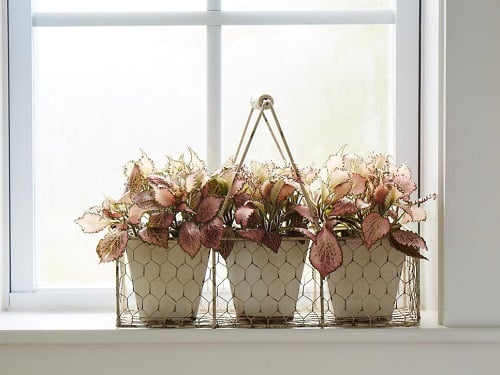Nerve Plant Care is easy and will help you to grow the pretty and bold Fittonia perfectly indoors! Here are all the details you’ll need!
Nerve plants are one of the boldest plants you’ll ever come across! Growing them can be tricky as they are very fussy about their watering schedule and will wilt if you’re going to ignore them for a while! Here is all the information you need for Nerve Plant Care to make them steal all the attention!
Botanical Name: Fittonia argyroneura
Common Names: Mosaic plant, Nerve plant, Fittonia, Net Plant, Painted net leaf plant
Check out our article on cute small houseplants here
Popular Nerve Plant Varieties to Grow
- Angel Snow Nerve Plant has rich green leaves veined in a white hue.
- Fortissimo Nerve Plant comes with green leaves and pinkish-red veins.
- Black Star Nerve Plant has dark green leaves that are steaked in bold purplish-red color.
- Josan Nerve Plant has green and vibrant red leaves. It is a medium-sized plant.
- Juanita Nerve Plant is a lovely indoor plant with bold, large leaves & bright red veins.
- Daisy Nerve Plant has extensive gray-green leaves with white veins.
- Leather Leaf Nerve Plant is a low light houseplant with significant white vegetation and bright white veins.
- Frankie Nerve Plant is a beautiful indoor plant. This variety is unique as its dark green leaves have more pink color than green.
Propagating Nerve Plants
Nerve plant propagation can be done from leaf cuttings. Place the leaf-cutting in water and keep it in a warm and bright place. Within 4-8 weeks, the cuttings will form roots. To speed up the process, you can also use a powder rooting hormone.
Nerve Plant Growing Requirements

Location
Have north or east-facing windows in your home? Perfect! Keeping the plant near them will help it to get bright, indirect light. Do make sure that you are never placing the plant in direct sunlight for a full day.
Soil
Your usual houseplant potting medium should be fine for it. Just make sure it drains well and has the ability to slightly retain the moisture.
Water
If you want to see your fittonia thrive, then you will have to be careful about the watering procedure. The plant will wilt if it goes dry even for a day. However, overwatering will also kill the plant. The best is to go for a “barely moist” soil. Feeling the topsoil for moisture between watering spells will be a great idea.
Nerve plant Care

Humidity and Temperature
Fittonia does well in a temperature range of 60-80 F (16-27 C), a common temperature in many homes. As the plant needs good humidity to thrive, placing them in a bright bathroom or kitchen, by the window, will be good. However, avoid keeping the plant too close to the windows in winters, as the chilly breeze from the window can result in the death of your plant. The good old pebble tray also works wonders for the plant.
Fertilizer
Feed the plant, once in every 1-2 months with diluted, balanced fertilizer. Alternatively, you can also apply granular fertilizer. Follow the instructions at the label for the recommended amount.
Pruning
Regular pinching off the ends of the plant will promote dense and lush foliage. These plants rarely bloom, but if blooming starts, then pinching off the bud will make growth bushier.
Pest and Diseases
Thankfully, nerve plants are not prone to pests and diseases. However, if stressed, they can be attacked by mealybugs, spider mites, aphids, and gnats. These can be taken care of by spraying a neem oil or insecticidal soap solution.
Common Problems and Solution
- Dry and wrinkled leave indicates the absence of adequate humidity or too much direct sunlight. Try to place the plant in indirect sunlight and use a room humidifier in dry conditions.
- Droopy leaves are a sign of cold temperatures. Try to create an atmosphere that imitates the tropical condition where the plant can thrive naturally.
- Too much water results in pale, wilting leaves and mushy growth. To avoid, improve your watering habits.



